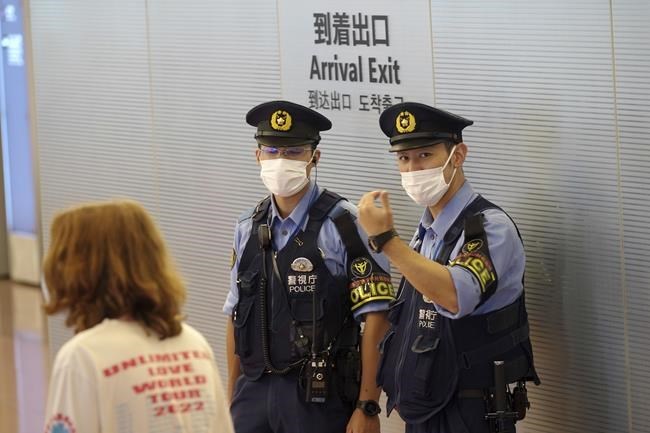TOKYO (AP) — Eager to admire colorful foliage, eat sushi and go shopping, droves of tourists from abroad began arriving in Japan on Tuesday, with the end of pandemic-fighting border restrictions that had been in place for more than two years.
"We got the news that we can finally come. We are really, really happy,” said Nadine Lackmann, a German who was among the crowd of tourists arriving at Tokyo's Haneda airport.
Travelers like Lackmann are expected to deliver a sorely needed 5 trillion yen ($35 billion) boost to the world’s third-largest economy. And the flood of visitors is expected to keep growing.
A daily limit of 50,000 arrivals is gone. Airlines have added flights in response to the full re-opening of borders. Visa-free travel is back for short-term business visits and tourism from more than 60 countries.
David Beall, a photographer based in Los Angeles who’s been to Japan 12 times, has already booked a flight, planning to go to Fukui, Kyoto, Osaka, and Tokyo. The last time he was in Japan was in October 2019. But it's everyday things the American is looking forward to, like eating Japan's popular pork cutlet dish, tonkatsu.
“As cliched as it sounds, just being back in Japan after all this time is what I am most looking forward to. That of course includes hopefully meeting new people, eating the food that I’ve missed like good tonkatsu, being in nature at that time of the year, riding the trains,” he said.
As a tip for others planning trips, he recommends getting a Japan Rail Pass and a Suica or some other pre-paid card that allows cashless payments for easy travel.
About 32 million tourists visited Japan in 2019, before COVID-19. Their return is welcome for good reason. Many will have more spending power because the in recent months in value compared to the U.S. dollar, the euro and other currencies.
The only protocols left for entry are that you must be fully vaccinated with one booster or have a negative PCR test within 72 hours of departure. Virtually all visitors from the U.S., the rest of Asia, Europe and South America who fulfill those requirements won’t have to quarantine.
In August, during the most recent coronavirus surge in Japan, nationwide daily new infections topped 200,000. By now, both case numbers and deaths have dwindled. Last week, daily deaths averaged eight people nationwide. The government has provided free COVID-19 vaccines, especially encouraging the elderly and the medically vulnerable to get inoculated.
Visitors may have to adjust to face masks, worn by most Japanese just about everywhere outside their own homes. Many stores and restaurants require customers to wear masks and sanitize their hands. Some establishments still close early, or have shuttered completely.
But bookings from abroad with Japanese carrier All Nippon Airways Co., or ANA, have already jumped five-fold compared to last week, while bookings of flights out of Japan have doubled.
Air Canada said bookings for 91Ô´´ travel to Japan jumped 51% this month compared to September, while the number of travelers from Japan to Canada grew 16% over the same period.
The Japanese economy .
Fitch Ratings forecasts that Japan’s economy will grow at a 1.7% annual pace this year and by 1.3% in 2023, supported by easy credit, a recovery for service industries and a gradual fix for supply-chain problems, which will boost manufacturing and exports.
Japan had basically shut its borders to tourists, but in June. Many people opted to wait for open-ended individual travel before booking their tickets.
With declining nervousness about the risks of infections, Japanese also are traveling more — encouraged by discounts offered by airlines, bullet trains, “onsen" hot springs resorts and hotels to jumpstart the ailing travel industry.
Although Japan offers various attractions from the ski slopes of northern Hokkaido to the semi-tropical beaches of the Okinawa islands in the south, experts say these months are the best for enjoying what Japan has to offer.
The mountains are vibrant with brilliant autumn foliage; the weather is moderate, not freezing, sweltering or humid; seafood, grapes, chestnuts and other culinary delights are fresh and plentiful.
“Now we are all ready to welcome people from abroad,” said Shuso Imada, general manager at the Japan Sake and Shochu Information Center.
His job is to promote sake rice wine and shochu liquor made from barley, potatoes or other vegetables, domestically and abroad.
“Autumn is the best season to enjoy Japanese food with sake and shochu,” he said.
That's why Javier Perez Toledo waited more than a year for his honeymoon.
“We are really passionate about the country,” he said, arriving from Spain. "We are so happy that we could come.”
___
Associated Press video journalist Haruka Nuga contributed to this report.
___
Yuri Kageyama is on Twitter at
Yuri Kageyama, The Associated Press


